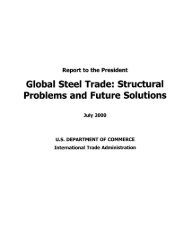Vietnam Environmental Technologies Export Market Plan
Vietnam Environmental Technologies Export Market Plan
Vietnam Environmental Technologies Export Market Plan
You also want an ePaper? Increase the reach of your titles
YUMPU automatically turns print PDFs into web optimized ePapers that Google loves.
Chart 1—Foreign Direct Investment in <strong>Vietnam</strong><br />
(as Percent of GDP), 1989–1999<br />
11<br />
10<br />
9<br />
8<br />
7<br />
6<br />
5<br />
4<br />
3<br />
2<br />
1<br />
1.9 1.8 2.0<br />
3.0<br />
7.3<br />
10.5 11.0 8.0 8.0<br />
3.0<br />
'89 '90 '91 '92 '93 '94 '95 '96 '97 '98 '99<br />
index, are believed to be the cause of the lower than<br />
expected inflation rate.<br />
<strong>Vietnam</strong> enjoyed a strong export performance in 1999,<br />
marking one of the economic highlights of the year.<br />
<strong>Export</strong>s rose to $11.5 billion, up 23.1 percent compared<br />
with 1998 (Table 1.4). The trade gap for 1999 slimmed<br />
to an estimated $113.0 million, from $2.0 billion in 1998.<br />
Imports rose 0.9 percent to $11.6 billion for the year.<br />
Table 1.3 Changes in <strong>Vietnam</strong>ese Consumer Prices,<br />
1998–1999<br />
Dec. Nov. Dec.<br />
1999 1999 1998<br />
Month-on-month<br />
change 0.5 0.4 0.8<br />
Year-on-year<br />
change 0.1 0.4 9.2<br />
Index* 100.1 99.6109.2<br />
*Base 100 = previous December.<br />
Source: World Bank, General Statistics Office, January 2000.<br />
2.5<br />
Table 1.4 <strong>Vietnam</strong>ese Balance of Trade 1995–1999<br />
(Billions)<br />
1999 1998 1997 1996 1995<br />
Merchandise<br />
exports $11.5 $9.4 $8.9 $7.1 $5.1<br />
Merchandise<br />
imports $11.6$11.4 $11.2 $11.1 $7.5<br />
Trade deficit $0.1 $2.0 $2.3 $4.0 $2.3<br />
Note: Smuggled goods estimated to add $1.5 billion to<br />
annual import totals.<br />
Source: World Bank, Ministry of Trade, 2000.<br />
Higher oil prices and <strong>Vietnam</strong>’s continuing ability to<br />
capitalize on its strength in agricultural commodities,<br />
such as rice and coffee, helped boost the country’s export<br />
performance in 1999. Meanwhile, imports have dropped<br />
as domestic economic growth has slowed, reducing<br />
demand for capital equipment.<br />
The long-awaited bilateral trade agreement with the<br />
United States is expected to boost these figures tremendously.<br />
Indeed, the trade agreement is now the key factor<br />
that will determine <strong>Vietnam</strong>’s economic health over the<br />
next three to four years.<br />
With the final agreement in July 2000, <strong>Vietnam</strong> would<br />
win Normal Trading Relations (NTR; formerly Most<br />
Favored Nation status) with the United States. The lower<br />
taxes on <strong>Vietnam</strong>ese goods, combined with <strong>Vietnam</strong>’s<br />
low labor costs, would result in a new influx of investment<br />
to produce items such as garments, textiles, shoes,<br />
and furniture. In the first year of NTR alone, it is expected<br />
that <strong>Vietnam</strong> would earn an additional $800 million in<br />
export sales. In the long term, the agreement would lead<br />
<strong>Vietnam</strong> to adopt market-opening measures that would<br />
benefit foreign investors and <strong>Vietnam</strong>’s private sector.<br />
2 U.S. Department of Commerce, International Trade Administration
















